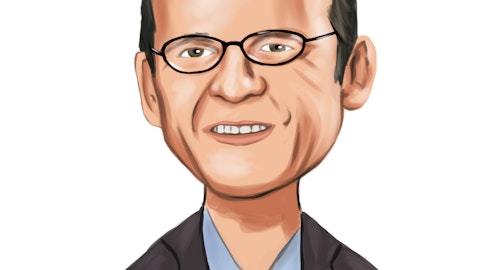Baris Oran: Hi, it’s Baris here. On the free cash flow side, we had $3 million positive in Q2, and we continue to guide for EBITDA to free cash flow conversion about 30%. This quarter was driven by our cash cost of our productivity integration initiatives, which was roughly $23 million cash outflow. The accounting charge was earlier, but the cash payment was this quarter, in the second quarter, and roughly around $40 million of timing of working capital. Our cost initiatives overall have very attractive ROI and payback, and it’s clearly seen in our projection and EBITDA upgrades and our CapEx is entirely in our control as we continue to scrutinize every dollar we spent. The prepaid debts around $115 million as you’re comfortable with second half, and our actions actually show the comfort level we have for the second half of the year.
Stephanie Moore: Got it. Thank you so much.
Baris Oran: Thank you.
Operator: Thank you. Our next questions come from the line of Scott Schneeberger with Oppenheimer. Please proceed with your questions.
Scott Schneeberger: Thanks very much. Yes, so a very strong new business win quarter. And, assume, I think you mentioned that, I’m not sure. I don’t recall, retention probably still mid-to-high 90s, but the organic growth did decelerate a bit. So, it sounds like that was a volume pressure, maybe consumer discretionary activity. Could you discuss what transactional volume was in the quarter, and where you expect that to go, and what you are doing with that variable cost management correspondingly? And then lastly, how we should see that come through in the margin over the next couple of quarters? Thank you.
Baris Oran: Hi, it’s Baris here. Let me help you out with the volumes, and the margin trajectory and how we manage our costs throughout our cycle. As I mentioned, we’ve seen some softness coming from retail vertical, our omnichannel retail and then strength in aerospace technology and food services, also geographically, our organic growth in Continental Europe has been very, very strong. So, as we look into, try to see it in the first couple of weeks of July. That trend tends to continue, but we started seeing further moderation and slightly improvement in some of our facilities in U.K. and U.S., it’s too early to call whether it’s a major optic or not, but we start to see to see moderation. As you would recall, roughly 70% of our cost structure is variable.
This business is designed to scale up and down costs, there are facilities that double in size during the peak and go back to its normal shape after the peak. So, we have the muscles to do that. And you’re seeing that in our — how our margin is very stable throughout the cycles. And remember, roughly half of our business is closed book, and half of our business is open book cost plus. So, that gives us a lot of resilience through cycles as you see it in our margins.
Scott Schneeberger: Thanks, Baris. And congrats on the EBITDA performance in the quarter, and the increase of the EBITDA. Could you just provide us a bit of, it’s kind of the components or the drivers of the EBITDA bridge from the prior guidance to where we are now. What’s really been behind that the main components? Thank you.
Baris Oran: Sure. The majority is coming from our productivity gains, not only at the central initiatives, but at the site level, our productivity has improved, and there is some support coming from the exchange rates as well. That’s making up the upgrade in the EBITDA.
Scott Schneeberger: Great. Thanks. I’ll turn it over.
Baris Oran: Thank you.
Operator: Thank you. Our next questions come from the line of Bascome Majors with Susquehanna. Please proceed with your questions.
Bascome Majors: Good morning. Your wins halfway through this year, as you talked about earlier, just give you a tremendous start on next year’s top line growth. And of course, the comps are going to get pretty difficult or at least more difficult, but the sales pipelines near record levels, and you’ve got another nine months or so to add more new deals that can move the needle before you get to ‘25. So, given taking it all together, and adding in that head start, Europe stabilization, maybe a soft landing in the U.S. looking more likely today than it did this time like last year. It does feel like next year setting up to reach or exceed your longer term view of that mid-to-high teens EBITDA growth over time. So, a lot of words to basically ask, is that kind of view towards 2024, at least on a preliminary basis, reasonable from where we sit today? And what could still get in the way of achieving that? Thank you.



